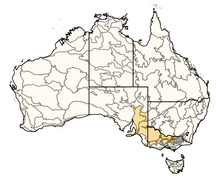Aha (wasp)
| Aha | |
|---|---|
| Scientific classification | |
| Domain: | Eukaryota |
| Kingdom: | Animalia |
| Phylum: | Arthropoda |
| Class: | Insecta |
| Order: | Hymenoptera |
| Family: | Crabronidae |
| Subfamily: | Crabroninae |
| Tribe: | Miscophini |
| Genus: | Aha Menke, 1977 |
| Type species | |
| Aha ha Menke, 1977
| |
| Species | |

| |
| A. ha distribution | |

| |
| A. evansi distribution | |
Aha is a
Taxonomic history
In 1977, the American entomologist Arnold S. Menke wrote a paper circumscribing the new genus Aha which was accompanied by his descriptions of its two species: A. ha and A. evansi.[3] Howard Ensign Evans and Robert Matthews had provided him with specimens of this new genus; they had collected them during expeditions in Australia in 1969–1970 and 1972.[4] Menke designated A. ha to be the genus's type species.[5] Menke only had access to male specimens when writing his description of the genus and both species.[6] Ole C. Lomholdt wrote a description of the female A. evansi in 1980.[7]
When Menke named Aha, he placed it in the tribe Miscophini due to its ocelli.[5] Lomholdt argued the genus should be in the tribe Larrini.[8] As of 2017[update], Aha is classified in the Miscophini tribe, of the Crabroninae subfamily of the Crabronidae family.[1][9]
Etymology
The etymology listed in Menke's 1977 paper is that "Aha is an arbitrary combination of letters chosen for brevity".
Distribution
A. ha's
Description
Lomholdt listed six
In Menke's key to genera in Miscophini, Aha was coupled with Lyroda. His diagnostic features included the placement of the forewing media divergence, a prementum which was compressed laterally, and claws of unequal sizes.[17]
References
- ^ a b "Aha". Hymenoptera Online (HOL). The Ohio State University. 2017. Retrieved 27 November 2017.
- ^ a b Lomholdt (1980), p. 241.
- ^ Menke (1977).
- ^ Menke (1977), p. 671.
- ^ a b c Menke (1977), p. 673.
- ^ Menke (1977), p. 672.
- ^ Lomholdt (1980).
- ^ Menke (1977), p. 244.
- ^ Pulawski, Wojciech J. (15 July 2014). "Family Group Names and Classification" (PDF). Archived (PDF) from the original on 15 June 2016.
- ^ Evans, Howard E. (1983). Menke, Arnold S. (ed.). "Tales from the Outback: The Discovery of Aha ha (Sphecidae, Miscophini)" (PDF). Sphecos. 7: 14.
- ISSN 0193-4511.
- ^ "The Crosscurrents" (PDF). Information Crossfile. Park Science: A Resource Management Bulletin. 2 (4). U.S. Department of the Interior: 17. 1982. Archived from the original (PDF) on 28 June 2017. Retrieved 28 November 2018.
- ISSN 1072-2556.
- ISSN 1046-2821.
- ^ a b Menke (1977), p. 675.
- ^ Lomholdt (1980), p. 242.
- ^ Menke (1977), p. 681.
Works cited
- Lomholdt, Ole C. (1980). "The female Aha evansi Menke, 1977 (Hymenoptera: Sphecidae, Larrinae)". Entomologica Scandinavica. 11 (2): 241–244. .
- Menke, A. S. (1977). "Aha, a new genus of Australian Sphecidae, and revised key to the world genera of the tribe Miscophini (Hymenoptera, Sphecidae, Larrinae)". Polskie Pismo Entomologiczne. 47: 671–681. ISSN 0032-3780.
External links
- "Genus Aha Menke, 1977". Australian Faunal Directory. Retrieved 27 November 2017.
